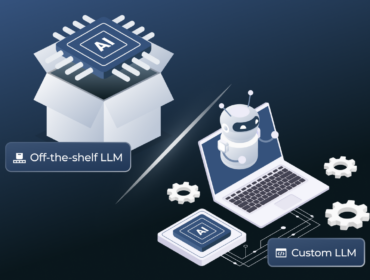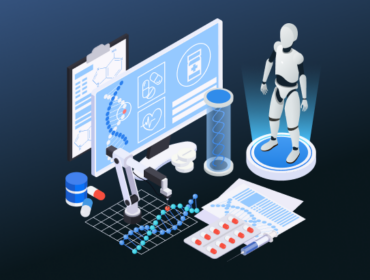Starting as a popular buzzword and even some sort of a hype word, blockchain has quickly become a truly invaluable business tool that is now used in nearly all industries we know — from fintech and supply chains to healthcare and even government tax monitoring.
This does not free blockchain from the stereotypes and the associated urban myths. “Blockchain is used mostly in the DarkNet”, “Blockchain is all about cryptocurrencies and shadow money transfers”, “Blockchain is expensive because you need dozens of computers to have it running” — these are only a few of the most common misconceptions about blockchain.
Let’s debunk some of these myths by answering some of the most commonly asked questions. From blockchain developers, in their own words.
What’s inside the blockchain?
Obviously, blockchain is a chain of [data] blocks. Physically speaking, blockchain is a chain of computers linked together to substitute the more traditional server. Blockchains can be public (anyone can access), private (authorized users send invitations to join), or consortium ones (usually used by a network of business organizations, highly popular in the finance sector). Apart from blocks and chains, there are three more keywords in the blockchain basics — transaction, node, and miner.
Transaction is the smallest block of records inside a blockchain.
Node stands for one user or one computer inside the blockchain system.
Miner is a node responsible for block verification (before this block gets added to a blockchain structure).
How much does blockchain really cost?
The cost of a blockchain always depends on two key factors — complexity of a blockchain project you have in mind and how the blockchain would be developed.
Developing a blockchain can be organized in at least three ways:
- Hiring developers for in-house work (usually recommended for the most data sensitive projects)
- Hiring freelancers
- Hiring a blockchain technology development company
Very rough estimations of a blockchain budget, as of 2021-2022, are usually in the range between $1,500 and 5,000.
Costs tend to be lower in the cases with public blockchains that heavily rely on open source. However, not many businesses would find this solution comfortable enough for their purposes.
How long does it take to make a blockchain?
Again, this would depend on the complexity of a project itself.
Developing the proof of concept usually takes from two weeks to two months.
Launch itself might take up to three months.
The timing might get extended if you are hiring several freelance developers who are working from different places. In most cases, hiring a readymade team from a blockchain technology development company would be the fastest option.
How can blockchain help my business?
As blockchain is very much transaction-oriented, all of its key benefits are also about transactions (financial and not only). Blockchain makes transactions:
- More transparent
- More traceable for absolutely all the participants involved
- Cheaper and quicker (though there might be exceptions when the traditional, server-based transactions are actually quicker).
Not to sound too abstract, let’s have some real-life examples.
First and foremost, blockchain is used for money transfers and other assets exchange purposes. It is secure, quicker (instant, actually), and much cheaper than any alternative way of transfers.
Medical institutions use blockchain applications to send and receive sensitive medical information.
Artists use blockchain to instantly receive royalty payments for their creative work (Spotify is probably the best known example of this arrangement).
Large businesses and charitable organizations use blockchain to organize and perform secure and anonymous auctions to sell valuable assets.
The list may go on forever.
In a nutshell, if you need to set up online transactions that are transparent but secure, blockchain is always a solid option to consider.
What are the key steps in a blockchain development process?
Once you have the key objective and the subtasks clearly formulated, further steps would be as follows:
- Сhoosing between public, private, and consortium blockchain
- Developing the proof of concept
- Visualizing and working on the language
- Coding work itself
- Launch and testing
- Full deployment.
What are the tools for blockchain development?
Even if you already know that you would be outsourcing the whole blockchain development process, you still need to know the jargon and the key tools for blockchain development.
Solidity and Go (also known as GoLang, where Lang stands for “language”) are the two most common languages used in blockchain development technology. Both are perfect for smart contracts and Ethereum blockchain platforms. Some developers would insist though that Python is the preferred language for smart contracts.
Geth – an Ethereum client that is used to run the nodes. It works equally well with Mac, Windows, and Linux. Once you have it downloaded and installed, you can actually create a new blockchain or link yourself to an already existing one.
When blockchain is using Ethereum, it needs a place to store tokens. This place is called an Ethereum wallet. The most well-known wallet is Mist, the Ethereum developers themselves once created it. However, Mist has been somewhat criticised recently. Tresor and Ledger are usually the most frequently mentioned alternatives to Mist.
Truffle Suite — a development environment and a testing framework for Ethereum works. Amazon, Microsoft, Airbus, Starbucks — all these companies are using blockchains developed in Truffle.
What can be the hidden pitfalls in the blockchain development process?
Like any other sophisticated project, blockchain development might become a failure due to several misunderstandings or overestimations. The most typical of them include the following:
- Building on a public blockchain instead of developing a private one from scratch;
- Assuming that blockchain is a complete business solution in itself;
- Using blockchain simply as a cloud storage, disregarding its transaction properties;
- Ignoring potential legal and governance issues;
- Finally, banal FOMO — the fear of missing out, and launching a blockchain project without a clearly written objective, just because every competitor is doing it.
Is there a one-fit-all solution?
You won’t make any mistake if you choose to go with the most standard set of tools in your blockchain development technology.
All other things won’t be universal though and need to be thoroughly discussed. One of the reasons why hiring a dedicated team from a blockchain technology development company is always a good idea if you are planning to use blockchain for business purposes.





![How to make a blockchain: a quick start guide What’s the EU Artificial Intelligence Act and How to Comply? [Webinar]](https://unicsoft.com/wp-content/uploads/2024/03/Cover_1140_v1.1-370x280.png)

